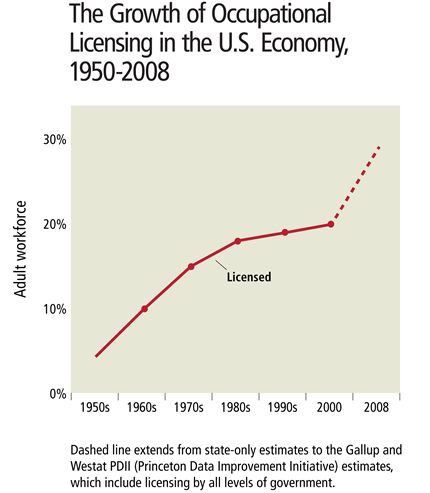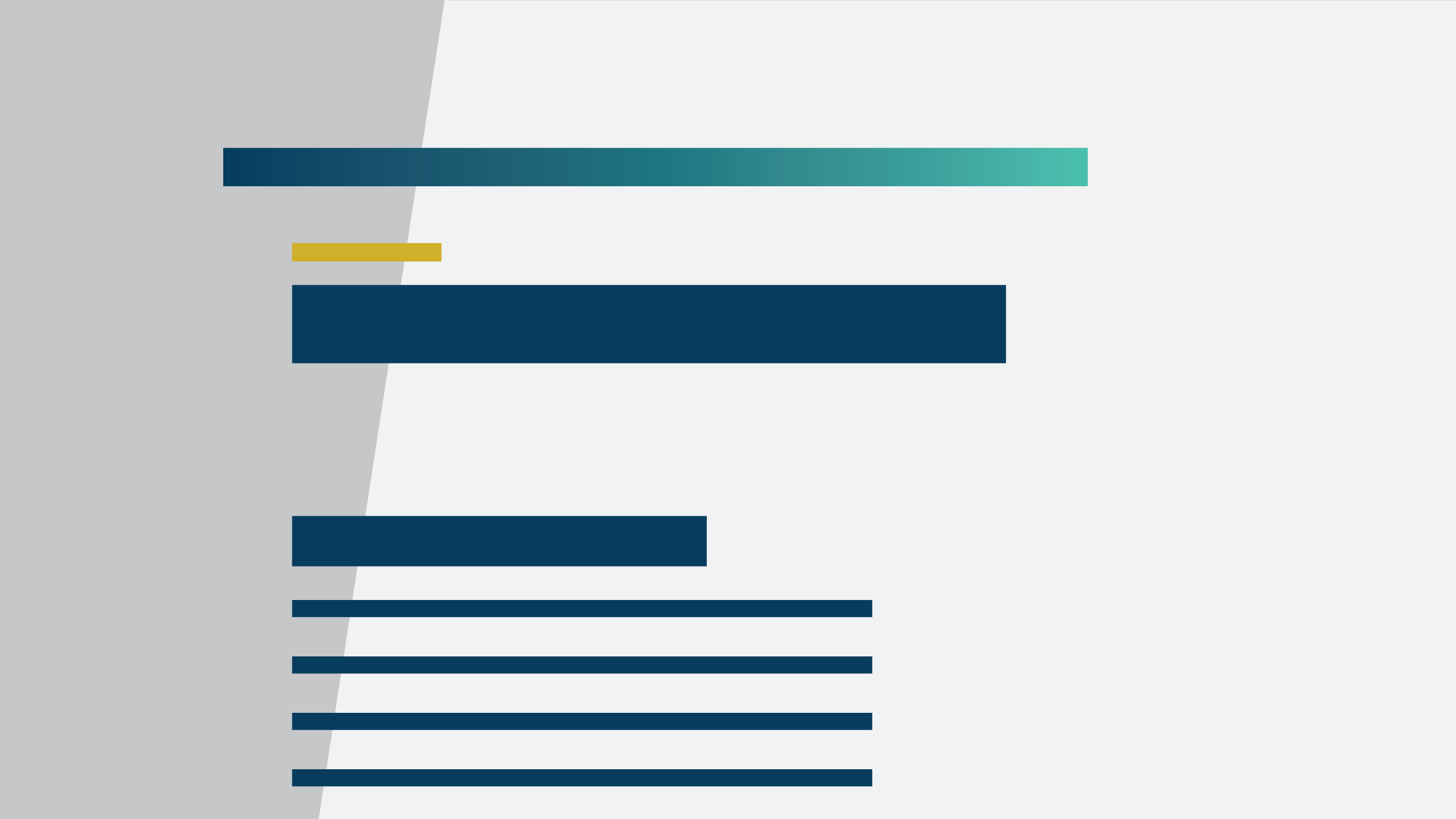Economic Policy Papers are based on policy-oriented research produced by Minneapolis Fed staff and consultants. The papers are an occasional series for a general audience. The views expressed here are those of the authors, not necessarily those of others in the Federal Reserve System.
Executive Summary
The growth of occupational licensing in the United States has resulted in higher labor costs, restricted services and other economic distortions, with relatively limited benefits in practice quality. This essay describes the state of such licensing, discusses pros and cons of the practice, and suggests several proposals to improve the current situation.
Introduction
Occupational licensure is the process by which governments (mostly the states in the United States, but also local governments and the federal government) set the legal qualifications required to become licensed to practice a trade or profession, after which only licensed practitioners are allowed to receive pay for doing the work in the occupation. This form of economic regulation has rapidly become one of the most significant factors affecting labor markets in the United States and other industrialized countries, similar to the guilds that dominated before the Industrial Revolution in Europe (Ogilvee 2014). Over the past several decades, the share of U.S. workers holding an occupational license has grown sharply, as shown in the accompanying figure, to almost 29 percent.

Research suggests that over 1,100 occupations are regulated in at least one state, but fewer than 60 are regulated in all 50 states, showing substantial differences in which occupations states choose to regulate (U.S. Executive Office of the President 2015). Funeral attendants are licensed in nine states, for example, but florists in only one.
It’s estimated that unlicensed workers earn 10 percent to 15 percent lower wages than licensed workers with similar levels of education, training and experience (Kleiner 2006; Kleiner and Krueger 2013). More specifically, Kleiner and Krueger (2013) find that licensing at the state level confers a wage premium of around 17 percent, and the combination of state and either federal or local licensing has an estimated effect of around 25 percent. Other research suggests that licensing can have a major economic effect in misallocating resources in numerous occupations and industries.
Possible benefits of licensing
An alternative perspective of occupational licensing by government argues that administrative procedures regulate the appropriate supply of labor in the market. Regulators screen entrants to the profession and bar those whose skills or character traits suggest a tendency toward low-quality output. The regulators further monitor incumbents and discipline those whose performance is below standards, with punishments that may include revocation of the license needed to practice. The process can thereby raise the overall quality of services to consumers.
Given the potential economic issues with occupational licensing, I propose several solutions for the negative consequences of regulation that could help reduce its adverse economic effects and lessen the distortions it may have on the U.S. economy.
Problems caused by licensing
The trend toward broader occupational licensure in the economy should be a source of interest to policymakers, if not an outright concern. Licensure makes it more difficult to enter a profession, which restrains the supply of service providers and can raise demand by suggesting that the service
is of higher quality. Consequently, the cost of services is higher for consumers.
Similarly, state or local licensure in the United States can diminish mobility by requiring service providers to fulfill new licensing requirements when they move from one geographic political jurisdiction to another. Labor service providers are thereby impeded in moving to where their services are most needed, thus reducing the efficiency with which labor services can be provided to the economy.
Licensure also restricts the scope of practice within certain professions. One such example: Dental hygienists cannot perform certain tasks or open independent offices because the law restricts the overarching tasks to only dentists. Another example: A licensed practical nurse in a hospital cannot do a task that state legislators or licensing boards have determined must be carried out by a licensed respiratory therapist (Wheelan 1998; Kleiner 2013).
In essence, occupational licensing is an economic monopoly given to certain workers that is enforced by the powers of the state.
Solutions
Policies that would allow more market-based systems, such as certification rather than full-fledged occupational licensing, may enhance both equity and efficiency in the economy. As with any form of regulation, policymakers must weigh the potential benefits of professional licensure against the costs of the subsequent labor market distortions. There are numerous potential drawbacks to licensure, even in cases where such regulation improves quality in the relevant profession. If licensure improves quality by restricting entry into the profession, then some consumers will be forced to pay for more “quality” than they want or need, or they may not be able to afford any service at all. Even in fields such as law or medicine that require graduate education, many services are quite basic and can be delivered by lower-quality service providers at lower costs.
These proposals focus on developing cost-benefit analysis of occupational licensing, on the federal government providing incentives to the states for regulatory innovation, on reducing barriers to interstate migration and on a general movement in the economy to less-restrictive forms of occupational regulation.
First, state and local governments should develop and execute a plan for evaluating existing occupational licensing requirements. The evaluations should be based on existing studies or new analyses. When the costs of regulation are shown to exceed the benefits, the requirements should be modified or dropped.
Second, the federal government can take a lead role in establishing a set of best practices through an evaluation of policies that have been shown to work and that may provide greater employment growth and lower prices while maintaining service quality. The federal government can also encourage states to reevaluate occupational regulation by providing grants similar to those in the Race to the Top education program; these grants would be paid for by the economic gains to the economy of greater deregulation.
Third, licensing standards should allow individuals to move across state lines with minimal retraining or residency requirements. When licensing is deemed to be in the interest of the public, weighed against the economic costs, states and localities should accept, as much as possible, licenses granted in other states. This proposal would facilitate mobility across states and would make it more difficult for special interests to tighten regulations in order to increase their monopoly status in a given state. For example, adopting this proposal among the 10 pairs of states with the most mobility between them would go a long way toward addressing the harmful impacts of licensing on an individual’s migration decisions.
Fourth, where politically feasible, state governments should reclassify certain occupations that are licensed to a system of certification or no regulation. This could be accomplished either by deregulating licensed occupations and turning them into certified ones or by creating competition from individuals who are certified by private organizations. These individuals would be able to work with licensed individuals if they have appropriate bonding to protect consumers against shoddy service.
Summary and conclusion
The proposals noted in this article would benefit many workers, including those who could forgo unnecessary requirements and long-term training. One outcome is that they would have a greater opportunity to find work in states that have more rapid employment growth and better-paying jobs. Consumers would benefit by having lower-cost goods. Current research suggests that this could be achieved with little to no effect on the overall quality of services.
If workers are allowed to enter more productive jobs, they will be more efficient and their output will be higher, raising the potential economic output of society. If workers, such as teachers, are allowed to more easily move across state lines to jobs that are more productive, they also will be more efficient. For teachers, this would allow movement to where population growth is highest and therefore reduce class sizes and offer enriched classes. One outcome could be enhanced human capital where the demand is the greatest.
Relaxing occupational licensing policies would result in an economy that is more efficient, equitable and productive, with the potential to raise economic growth through fewer labor market regulations.
References
Kleiner, Morris M. 2006. Licensing Occupations: Enhancing Quality or Restricting Competition? Kalamazoo, Mich.: Upjohn Institute for Employment Research.
Kleiner, Morris M. 2013. Stages of Occupational Regulation: Analysis of Case Studies. Kalamazoo, Mich.: Upjohn Institute for Employment Research.
Kleiner, Morris, and Alan Krueger. 2013. Analyzing the Extent and Influence of Occupational Licensing on the Labor Market. Journal of Labor Economics 31(Suppl. 1): S173-202.
Ogilvie, Sheilagh. 2014. “The Economics of Guilds.” Journal of Economic Perspectives 28 (4): 169-92.
U.S. Executive Office of the President. 2015. Washington, D.C.: The White House, p. 76.
Wheelan, Charles J. 1999. “Politics or Public Interest? An Empirical Examination of Occupational Licensure.” Unpublished manuscript, University of Chicago.





